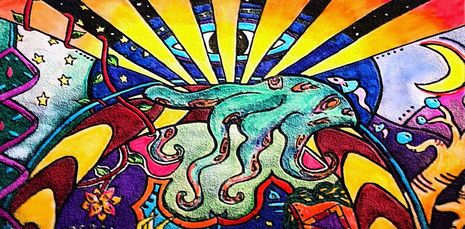The doors of perception: LSD sheds light on altered consciousness
Laura Ryan delves into the neuroscience behind psychedelics and considers their potential applications in healthcare

Research into psychedelics is undoubtedly undergoing a renaissance. Be it Silicon Valley blogs touting the benefits of ‘microdosing’ or the resurgence of New Age lifestyles, these funky drugs have tripped their way back into the public consciousness. Much scientific interest has focussed on the potential use of LSD, psilocybin (the active ingredient in magic mushrooms), and DMT (found in ayahuasca) as therapies for mental health and psychiatric disorders. But the use of neuroimaging techniques to study their effects on healthy brains has opened the door to a whole new type of functional analysis of the human mind. Understanding how neural networks are altered as a result of psychedelic drugs could bring us closer to unlocking one of the greatest scientific mysteries of all time – consciousness itself.
In 2016, it was suggested that the functional complexity of the resting brain approaches the maximum possible given the organ’s structural anatomy. Essentially, this means that because of the way the brain is physically laid out and how the different regions are connected together, it would be impossible for more complex patterns of co-ordinated electrical activity to occur than those which are seen in a resting state. But according to a paper published very recently in the journal NeuroImage, this is not the case at all. The study is the result of a collaboration between Cambridge University and the Centre for Psychedelic Research at Imperial College London, and it has shed new light on the neurobiological basis for the mind-altering effects of LSD.
To investigate the effects of LSD on the network activity of the human brain, researchers used functional MRI scans to examine the effects of the drug on healthy participants. Their findings were absolutely intriguing; after taking an active dose of LSD, the participant’s brains were in fact capable of an unusual increase in functional complexity, triggering a “profoundly altered state of consciousness”. Cambridge researcher Andrea Luppi – first author of the paper – explained that this is “largely the opposite of what happens during anaesthesia”.
“The widely reported feeling of ego dissolution (or loss of sense of self), that often accompanies an acid trip is a result of this type of abnormal rerouting of brain networks”
The increased complexity was a result of an apparent ‘decoupling’ of functional complexity from the structural arrangement of connectivity in the brain - in essence, a ‘freeing’ of the mind from the brain’s usual anatomical constraints. This decoupling effect alters the way that different areas of the brain communicate with each other and coordinate their activity. The widely reported feeling of ego dissolution (or loss of sense of self), that often accompanies an acid trip is a result of this type of abnormal rerouting of brain networks. Galaxy brain stuff!
But what does any of this actually mean?
Well, an explanation can be provided in the form of an imperfect (but hopefully helpful) analogy. Picture a town like Cambridge, with a highly structured system of roads and cycle lanes connecting its various hubs. Now imagine that one day, all of the usual routes are switched up; busy roads are blocked, quiet lanes become crowded, one-way roads switch direction, and the most intrepid drive cross-country over Parker’s Piece. The physical capacity for these complex and novel routes was always there, but this unusual functional set up just wasn’t the way that the roads were originally planned. And for good reason – while people on an acid trip may find new meaning in the backs of their hands, or feel at one with the universe and all its inhabitants, our species would not have survived very long had our brains evolved to behave that way all the time.
“Our species would not have survived very long had our brains evolved to behave that way all the time”
But that’s not to say that psychedelics can’t have beneficial effects. The authors of the paper note that their findings echo a central tenet common to many theories of psychedelics from as early as the 19th century: that psychedelic compounds “perturb adaptive mechanisms which normally constrain perception, emotion, cognition, and self-reference”. This leaves the brain free to experience new and unusual patterns of connectivity that transcend those that it has evolved to rely on, opening the door to the profoundly new perspectives reported by many users of psychedelic drugs. Personal insights that can be gained while on a ‘good trip’ are said to persist long after the acute effects of the drugs have worn off, with advocates reporting they have experienced a permanent expansion of the mind. It would of course be remiss not to note that in rare instances, psychedelics can provoke serious psychotic reactions, particularly in those with family histories of psychiatric disorders.
The data presented in the paper referred to earlier are not only relevant to our theories of consciousness; they also provide justification for practical approaches for the treatment of mental health disorders like depression and PTSD. Despite previous claims, our brains are capable of states of complexity beyond that which we experience in our daily lives, and when we enhance that complexity – whether that be through psychedelics, pharmacological agents, or other interventions entirely – we can alter a person’s subjective experience of the world. The number of clinical trials making use of LSD, magic mushrooms, or MDMA for the treatment of psychiatric conditions has shot up over the past decade, and it is clear that these drugs are slowly entering the medical mainstream. Initial results have been fairly astonishing. But with so many regulatory barriers to overcome, it’s a long road ahead for advocates of psychedelic therapies.
 News / CUP announces funding scheme for under-represented academics19 December 2025
News / CUP announces funding scheme for under-represented academics19 December 2025 News / Cambridge welcomes UK rejoining the Erasmus scheme20 December 2025
News / Cambridge welcomes UK rejoining the Erasmus scheme20 December 2025 News / SU reluctantly registers controversial women’s soc18 December 2025
News / SU reluctantly registers controversial women’s soc18 December 2025 Film & TV / Timothée Chalamet and the era-fication of film marketing21 December 2025
Film & TV / Timothée Chalamet and the era-fication of film marketing21 December 2025 News / News in Brief: humanoid chatbots, holiday specials, and harmonious scholarships21 December 2025
News / News in Brief: humanoid chatbots, holiday specials, and harmonious scholarships21 December 2025









